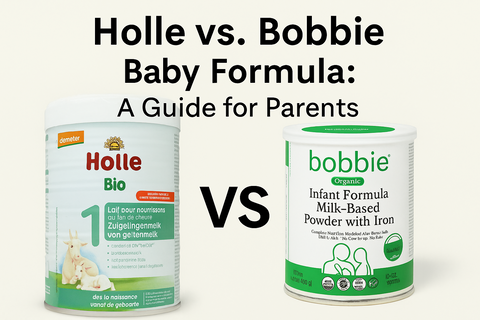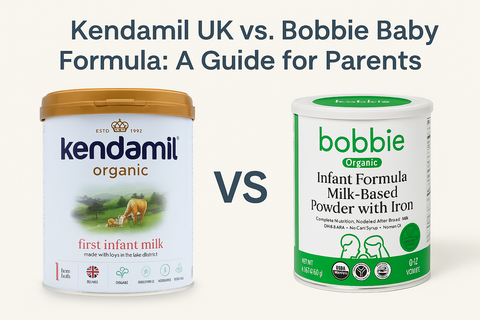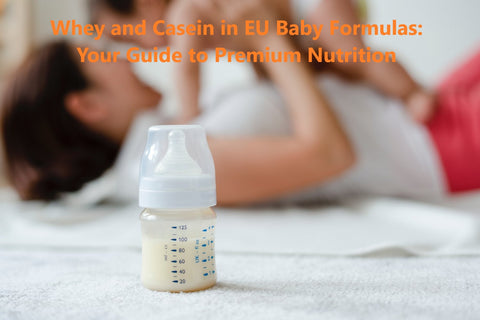Mixing Formula with Breast Milk: Is Combination Feeding Okay for Babies?
When it comes to nourishing your little one, the world of infant feeding can be a labyrinth of options and decisions. Your main priority is making sure your little one is getting all of the vitamins and nutrients that they need to grow healthy and strong. In your quest to feed your baby as best as possible, you might wonder if mixing formula with breast milk is a good thing to do.
The great thing for parents and caregivers is that you don't have to choose just one! While breastfeeding is preferable, using organic formula can also be a a healthy choice and lifesaver. Combination feeding methods, using pumped breast milk for some meals and baby formula for others, lets you and your baby enjoy the health advantages of breastfeeding and the convenience of formula feeding. This approach also provides an alternative when medical or daily situations require a different nutritional choice.
Finding a balance is possible, ensuring your baby gets the proper nutrition while giving yourself a bit of relief. In this blog, we are going to discuss the pros and cons of combining breastmilk and formula, answer common questions, and give you proven tips on how to implement mixed feeding.
Can Breastfeeding and Formula Feeding be mixed?
Yes, breastfeeding and formula feeding can be combined or mixed to create a feeding routine that suits your baby's needs and the parent's circumstances. This approach, often called combination or mixed feeding, involves alternating between breastfeeding and offering formula milk.
Combining breastfeeding and formula feeding offers flexibility, allowing parents to provide breast milk's benefits while supplementing with formula when necessary. Some parents choose to breastfeed their baby for some feeds and use the formula for others, depending on various factors such as milk supply, work schedules, convenience, and the baby's nutritional needs (we'll get back to this later).
When to consider combination feeding?

Combination feeding can be a practical option in various scenarios:
- Low Milk Supply: Combination feeding could be a solution if you're struggling to produce enough breast milk to meet your baby's needs despite trying different techniques to boost supply naturally.
- Mom's Well-being: For mothers who feel overwhelmed, exhausted, or stressed due to the demands of exclusive breastfeeding, introducing formula can provide a break and alleviate some pressure, allowing them to take care of their well-being.
- Multiple Babies: Moms of twins or multiples might struggle to produce enough milk to feed all their babies adequately. Combination feeding ensures all babies receive enough nutrition without overwhelming the mother.
- Sleep and Break Needs: New parents, particularly mothers, might need extra sleep or a break. Allowing a partner or caregiver to feed the baby formula at specific times can provide the much-needed rest.
- Returning to Work: When a mother returns to work and finds it challenging to manage pumping schedules or cannot pump enough milk during work hours, combination feeding can help maintain the baby's nutritional needs.
- Medical Reasons: In some cases, medical conditions or medications might hinder breastfeeding. Combination feeding ensures the baby gets proper nutrition while accommodating the mother's health requirements.
Ultimately, it's essential to consider individual circumstances, consult with healthcare providers or lactation consultants, and make an informed decision that works best for both the baby and the mother or caregiver. Combination feeding offers flexibility and can be a helpful solution in various situations, but it's crucial to approach it with adequate information and support.
What are the pros and cons of combination feeding?
The mixed feeding method has several advantages and a couple of possible drawbacks. Now, let's explore the positives and negatives of this approach:
Pros:
- Flexibility: Combination feeding provides flexibility, allowing parents to share feeding responsibilities and accommodate various schedules, which can be beneficial for working parents or those needing more flexibility.
- Eases Pressure: It can reduce the pressure on the breastfeeding parent, offering a break and allowing others to participate in feeding, which can be comforting and helpful for bonding.
- Supplementing Nutrients: Formula can supplement nutrients that might be lacking in breast milk, especially when the mother's milk supply is insufficient or if certain nutrients need to be specifically addressed.
- Soothing Baby: Formula can sometimes be more filling for babies, leading to longer sleep stretches, which can benefit exhausted parents.
- Health Considerations: In cases where breastfeeding is impossible due to medical conditions or medications, combination feeding ensures the baby receives the necessary nutrition.
Cons:
- Potential Impact on Milk Supply: Introducing formula can sometimes lead to a reduced milk supply if breastfeeding sessions are replaced too frequently, making it harder for the parent to breastfeed exclusively later on. (more about this later in this blog)
- Expense and Preparation: Formula feeding can be more costly and requires preparation, such as sterilizing bottles and preparing formula, which can be time-consuming compared to breastfeeding.
- Altered (Taste) Preferences: Some babies may develop a preference for the taste and the bottle, making it harder to transition back to exclusive breastfeeding.
- Complexities in Digestion: Formula and breast milk digest differently, which might cause digestive issues or discomfort in babies transitioning between the two. Contact our Formula Experts, who are here to answer most of your formula-related questions and can guide you in making the best choice of which formula to order. We carry a variety of Specialty formulas like Hipp Hypoallergenic, Hipp Comfort, and the Anti Reflux vegetarian formulas of BebeM.
- Emotional Challenges: Combination feeding might evoke feelings of guilt or disappointment in parents who initially aimed for exclusive breastfeeding but had to incorporate formula due to various reasons.
It's important to note that the decision to engage in combination feeding should be based on individual circumstances and preferences. Consulting with healthcare providers or lactation consultants can offer tailored guidance to make informed choices that prioritize the baby's health and the parent's well-being.
Can you mix breast milk and formula in the same bottle?

Yes, mixing formula and breast milk in the same bottle is safe. Alternatively, if you supplement with formula, it may be a better option to keep formula and breastfeeds separate for a couple of reasons:
- To keep your breast milk from going to waste if your baby doesn’t finish the entire bottle in one feeding.
- To keep the breastfeeding experience, which is a beneficial and intimate moment that can strengthen the bond between mother and baby.
However, if you choose to mix formula and breast milk in the same bottle, it's important to keep a few things in mind:
- Safe Handling: Ensure that the breast milk and formula are handled properly and not contaminated before mixing them. Follow proper hygiene practices and use clean bottles, nipples, and hands while preparing and handling the milk.
- Temperature: If you're mixing freshly expressed breast milk with formula, ensure they are both at the same temperature before combining them. Mixing warm breast milk directly with cold formula is not recommended as it might affect the consistency and temperature your baby prefers.
- Storage and Use: Mixed breast milk and formula should be used immediately and not stored for later use unless your healthcare provider advises otherwise. Follow guidelines for storing and using breast milk and formula separately.
- Consult a Healthcare Professional: If you're considering combining breast milk and formula regularly or for specific reasons, it's a good idea to consult a healthcare provider or a lactation consultant for guidance tailored to your situation.
While combining breast milk and formula in the same bottle can be done, it's crucial to prioritize safe handling practices to ensure your baby receives safe and nutritious feeding.
Combination feeding while transitioning
Transitioning from breastfeeding to formula feeding in a relatively short period, such as within two weeks, can be done gradually to help minimize discomfort and avoid complications for both the baby and the breastfeeding parent. Here's a suggested approach:
Week 1:
- Introduce Formula Gradually: Start by replacing one breastfeeding session with a daily formula feed. Choose a feeding time when your baby is less hungry to introduce the formula. This can help your baby adjust gradually.
- Monitor Baby's Response: Watch for any signs of discomfort or resistance from your baby. Be attentive to their cues and ensure they accept the formula without issues.
- Pump to Relieve Discomfort: As you reduce breastfeeding sessions, your body might become engorged or uncomfortable. Use a breast pump to relieve discomfort gradually without fully draining the breasts, as this will signal your body to decrease milk production slowly.
Week 2:
- Continue Replacing Feedings: Gradually replace more breastfeeding sessions with formula feeds over the second week. Aim to replace one or two additional sessions per day, depending on your baby's and your own comfort levels.
- Maintain Comfort: Use a breast pump to relieve discomfort as needed, but gradually reduce the duration and frequency of pumping sessions as your milk supply decreases.
- Offer Comfort and Bonding: During formula feedings, maintain close physical contact with your baby to provide comfort and bonding, as you did during breastfeeding.
General Tips:
- Stay Hydrated and Eat Well: Ensure you take care of your nutrition and hydration during this transition period.
- Seek Support: It can be an emotional time. Seek support from friends, family, or support groups to cope with the transition emotionally.
Remember, each baby and parent's experience transitioning to formula feeding is unique. It's important to be patient, listen to your baby's needs, and seek advice from healthcare professionals or a lactation consultant if you encounter challenges during this transition period.
10 tips on how to protect your milk supply while transitioning

As mentioned earlier in this blog, It's important to note that introducing formula to a breastfeeding routine might affect milk supply. Especially if breastfeeding sessions are replaced by formula feeds frequently. Protecting your milk supply while transitioning away from breastfeeding or when you're incorporating formula feeding is key. Combining breast milk and formula can be a personalized and practical approach. These tips aim to make the transition smoother for both you and your baby and can help maintain your milk supply:
- Gradual Transition: If you're introducing formula or reducing breastfeeding sessions, do it gradually over time. Abrupt changes can signal your body to produce less milk.
- Frequent and Effective Emptying of Breasts: If you continue to breastfeed, ensure that you are emptying your breasts effectively during feedings or pumping sessions. This signals your body to produce more milk.
- Pumping or Hand Expression: If you're skipping breastfeeding sessions or introducing formula, pump or hand express milk during those times to maintain stimulation and signal to your body that milk is still needed.
- Hydration and Nutrition: Stay well-hydrated and maintain a balanced diet. Consuming enough fluids and nutritious food can support milk production.
- Avoiding Long Gaps Between Feeds: Try to maintain a consistent feeding schedule or pump regularly to prevent long gaps between breast emptying sessions, which can reduce milk production.
- Comfort Measures: Use warm compresses or take a warm shower before pumping to encourage a letdown and maximize milk flow.
- Skin-to-Skin Contact: Skin-to-skin contact with your baby, even if not directly breastfeeding, can help stimulate milk production and promote bonding.
- Avoid Overusing Pacifiers or Bottles: Overusing pacifiers or bottles may decrease the baby's demand for breast milk, potentially affecting your milk supply.
- Relaxation Techniques: Stress can impact milk supply. Practice relaxation techniques like deep breathing or meditation to help manage stress levels.
- Get Support: Seek guidance from a lactation consultant or healthcare provider for personalized advice and support during the transition period.
Remember, every person's body reacts differently to changes in feeding patterns. If you're concerned about your milk supply or encounter difficulties, seek advice from a healthcare professional or a lactation consultant to address any issues and ensure you're taking the proper steps to protect your milk supply.
Can Formula Make My Breastfed Baby Sick?
Selecting the right type is crucial when transitioning your breastfed baby to formula. Opting for a premium European Organic Infant formula that's specifically formulated to closely mimic breast milk is beneficial. These formulas are designed to provide essential nutrients, supporting your baby's growth and overall well-being. They often contain high-quality ingredients and aim to replicate the composition of breast milk as closely as possible. These formulas exceed the EU requirements set by the European Food Safety Authority for organic certification, which are much stricter than organic standards in the United States. This ensures it is 100% free from steroids, pesticides, soy, refined sugar, growth hormones, and non-medically necessary antibiotics. Organic Formula Shop offers a wide range of Organic Formulas like Cow, Goat, Vegetarian, HypoAllergenic, and Specialty Formulas. We're specialized in the best European Brands as HiPP, Holle, BebeM and Lebenswert for all ages: Stage Pre & 1 (0-6 months), Stage 2 (6+ months), Stage 3 (10+ months) and Stage 4(12-36 months).
It's important to note that every baby is different, and while most babies transition between breast milk and formula without issues, some may have mild reactions to formula. These reactions might include:
- Gastrointestinal Issues: Some babies might experience gas, fussiness, or changes in stool consistency when formula is introduced due to digestion differences between breast milk and formula.
- Allergies or Sensitivities: Rarely, babies might have allergic reactions or sensitivities to specific ingredients in the formula, leading to symptoms like rashes, hives, vomiting, or diarrhea. Consult with your pediatrician to choose the best formula for your baby. Check out our HypoAllergenic, and Specialty Formulas.
To minimize potential discomfort or reactions when introducing the formula, consider the following:
- Gradual Introduction: Start by introducing formula gradually, replacing one breastfeeding session at a time to allow your baby's digestive system to adjust slowly.
- Choose Appropriate Formula: Opt for formulas designed for sensitive stomachs or those closely resembling breast milk in composition, if possible. Consult with your pediatrician to choose the best formula for your baby. Check out our HypoAllergenic, and Specialty Formulas.
- Monitor Your Baby: Observe your baby's reactions closely when introducing formula. If you notice persistent or severe symptoms, consult a healthcare professional to rule out any underlying issues or allergies.
Remember, it's normal for babies to have an adjustment period when introducing new foods or liquids, including formula. Most babies adapt well, but if you're concerned about your baby's reaction or health, seeking guidance from a healthcare provider or a pediatrician can provide reassurance and help address any potential issues.
In summary
Breast milk and formula don’t have to be mutually exclusive but can be the perfect combination. Your little one can thrive on breast milk, formula, or both. Keep them separate, mix them, nurse or pump, and find what works for you and your newborn.
Organic Formula Shop offers safe European formulas that will give you peace of mind and comfort. It’s key to know that you are giving your baby nutrition that mimics breast milk as closely as possible and is made with premium organic ingredients. Contact our dedicated customer support team at Organic Formula Shop for expert advice and guidance tailored to your baby's needs. They have earned hundreds of 5-star reviews from our customers, helping you to provide the best nutrition for your little one. Contact us here or shoot us an email at support@organicformulashop.com.
Just keep some essential safety precautions in mind when preparing bottles, and you’ll figure it out in no time. You’ve got this!
Please note:
This article is not medical advice. If considering mixed feeding, seeking guidance from healthcare professionals or lactation consultants who can offer advice tailored to individual circumstances is advisable. They can provide information on introducing formula, maintaining milk supply, and meeting the baby's nutritional requirements while accommodating the parent's needs and preferences.




